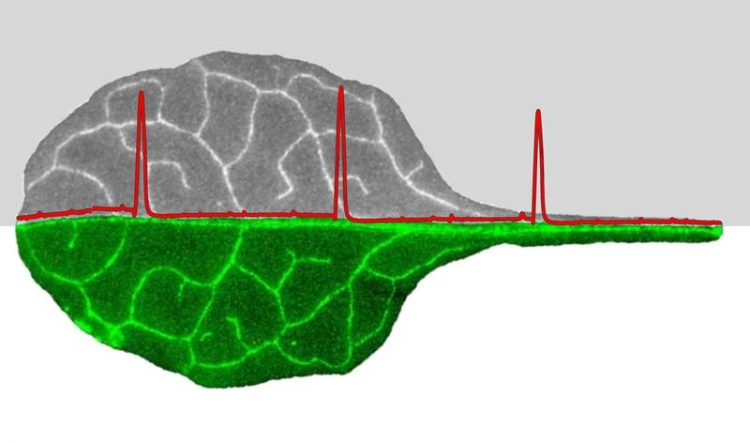Aphids as biosensors

Electrical signals travel alongside the sieve tube elements of plants. Picture: Rosalia Deeken / Sönke Scherzer /Christian Wiese
When a plant is mechanically injured or exposed to cold, it will send electrical signals through its body. In both cases, the signals cover large distances of as much as ten centimetres and more. The signals travel from the areas that have been injured or exposed to cold to all other organs which then react accordingly, for example by synthesizing proteins that protect the plant against cold.
An injury triggers totally different electrical signals than a cold shock. Biophysicist Professor Rainer Hedrich of the Julius-Maximilians-Universität Würzburg (JMU), Germany, and his team made this discovery using the model of thale cress (Arabidopsis thaliana).
A cut injury at a leaf triggers relatively slow electrical pulses over several minutes. Exposure to cold, in contrast, causes quicker pulses about 15 seconds long. “These differences indicate that the electrical signals each have a specific meaning,” Hedrich further.
Electrical signals at the sieve tubes
Could this principle be similar to that of the human nervous system? Here, electrical signals travel alongside specialized cells, bridge synapses and ultimately trigger a response in the body. Plants, however, do not have a brain, nor nerve cells or synapses. According to Hedrich, there is hence no serious scientific evidence to attribute intelligence to plants and proclaim a “plant neurobiology”.
Nevertheless, many researchers today are convinced that plants also use electrical signals to exchange information between the organs of their body. Hedrich's work on the Venus flytrap has even demonstrated that the carnivorous plant is capable of counting the electrical signals sent and make decisions based on this.
Such signals can be measured in the sieve tube elements which form a system of interconnected cells that pervades the entire plant like a vascular system and usually transports sugar and other substances.
Measuring signals difficult previously
Are the sieve tubes the “green power cable” or even some kind of “nervous system of the plant? This assessment is controversial – due to a methodical issue among others: So far, scientists have not had the proper tools to measure the transmission of electrical signals in plants over longer distances.
Rainer Hedrich, Vicenta Salvador-Recatalà and Ingo Dreyer have now developed an elegant solution to this problem which they publish in the science magazine “Trends in Plant Science”: The plant scientists used aphids as biosensors. They enhanced a method that has been known since 1964 which involves an electric circuit being generated between the aphid and the plant.
Aphids allowed to suck for the benefit of research
How that works? Aphids puncture the phloem vessels of plants and suck the sugary sap. If a fine wire is glued to their body and connected to an electrode sitting in the earth of a potted plant, an electric circuit is created between aphid and plant. It allows measuring how the electrical signals propagate in the sieve tubes.
This method will now be used to answer a number of questions. How and where are the signals created? What kind of information do they carry? Where are they registered and what reactions do they trigger? So there is still plenty of work for the Würzburg scientists to do – as well as for the plant lice that puncture and suck in the name of science.
“Electrical Wiring and Long-Distance Plant Communication”, Rainer Hedrich, Vicenta Salvador Recatalà, Ingo Dreyer, Trends in Plant Science, 12 February 2016, DOI: 10.1016/j.tplants.2016.01.016
Contact
Prof. Dr. Rainer Hedrich, Department of Botany I of the University of Würzburg, Phone: +49 931 31-86100, hedrich@botanik.uni-wuerzburg.de
Media Contact
More Information:
http://www.uni-wuerzburg.deAll latest news from the category: Life Sciences and Chemistry
Articles and reports from the Life Sciences and chemistry area deal with applied and basic research into modern biology, chemistry and human medicine.
Valuable information can be found on a range of life sciences fields including bacteriology, biochemistry, bionics, bioinformatics, biophysics, biotechnology, genetics, geobotany, human biology, marine biology, microbiology, molecular biology, cellular biology, zoology, bioinorganic chemistry, microchemistry and environmental chemistry.
Newest articles

Properties of new materials for microchips
… can now be measured well. Reseachers of Delft University of Technology demonstrated measuring performance properties of ultrathin silicon membranes. Making ever smaller and more powerful chips requires new ultrathin…

Floating solar’s potential
… to support sustainable development by addressing climate, water, and energy goals holistically. A new study published this week in Nature Energy raises the potential for floating solar photovoltaics (FPV)…

Skyrmions move at record speeds
… a step towards the computing of the future. An international research team led by scientists from the CNRS1 has discovered that the magnetic nanobubbles2 known as skyrmions can be…





















